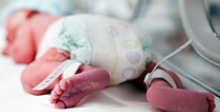Internal mini form
Contact Us Today
Complications that increase a child’s chance of developing Cerebral Palsy can arise during pregnancy or during labor and delivery. Newborns are assigned an Apgar score. Learn what your child’s score means.
What complications can occur during birth?
Complications that increase a child’s chance of developing Cerebral Palsy can arise during pregnancy or during labor and delivery. Formerly, it was believed a complicated birth (in combination with asphyxia) was the sole cause of Cerebral Palsy. Now it’s known that complicated birth in combination with asphyxia accounts only for a relatively small percentage of Cerebral Palsy cases, less than 10%.
Research indicates that events occurring during fetal development can also cause complicated delivery.
Apgar Score
Newborns are tested after birth and assigned an Apgar score. An Apgar score is a method to quickly summarize an infant’s health based on respiration, muscle tone, reflexes, color, and heart. A low Apgar score is a significant risk factor for Cerebral Palsy. Newborns are evaluated at one minute and five minutes after birth, and at subsequent intervals, if necessary. Five criteria are scored on a scale of 0 to 2 (for the one minute and five minute readings). Both scores are added together. A score of:
- Normal – 7 to 10
- Low – 4 to 6 low
- Critical – 0 to 3
The five criteria are:
- A: Appearance – skin color and complexion
- P: Pulse – heart rate
- G: Grimace Response – crying or grimacing when stimulated
- A: Activity – muscle tone where flexed arms and legs resist straightening
- R: Respiration – quality of breathing, based on rate and effort
Other birth complications heighten the odds of asphyxia occurring, or increase probability that a child will develop Cerebral Palsy. These complications include but are not limited to:
- Abnormal presentation or breech birth in which the baby enters the birth canal in a manner other than head first
- Emergency cesarean sections (C-sections)
- Prolonged second stage of delivery (from the point when the cervix is dilated to 10 cm through delivery)
- Premature separation of the placenta from the mother’s uterus
- Premature rupture of the membranes in which the amniotic sac ruptures prior to labor
Were you or your child at risk – before, during or after your child’s birth?
Cerebral Palsy risk factors are events, substances or circumstances that increase the chances of a child developing Cerebral Palsy. They can be avoidable, or unavoidable. A risk factor does not ensure a child will develop Cerebral Palsy; it means chances are higher than if that risk factor was not present. Likewise, the absence of risk factors does not ensure that a child will not develop Cerebral Palsy. Have you been exposed to the following risk factors?
- Cerebral Palsy Risk Factors
Types of risk factors:
- Asphyxia and oxygen deprivation
- Blood type incompatibility or jaundice
- Complications of birth
- Infection
- Intrauterine growth restrictions
- Multiple births and infertility drugs
- Parental health and habits
- Placenta complications
- Premature birth
- Traumatic brain damage
Risk factors vs. risk factor causal pathways
A risk factor does not ensure a child will develop Cerebral Palsy; it means chances are higher than if that risk factor was not present. Likewise, the absence of risk factors does not ensure that a child will not develop Cerebral Palsy.
- Risk Factors and Risk Factor Causal Pathways
The Cerebral Palsy Risk Factor Checklist
Any exposure to risk factors prior to conception and during pregnancy should be immediately discussed with a doctor in order to treat and minimize risk. The Cerebral Palsy Risk Factor Checklist helps parents determine if they may have been exposed to risk factors for Cerebral Palsy.
- The Cerebral Palsy Risk Factor Checklist









